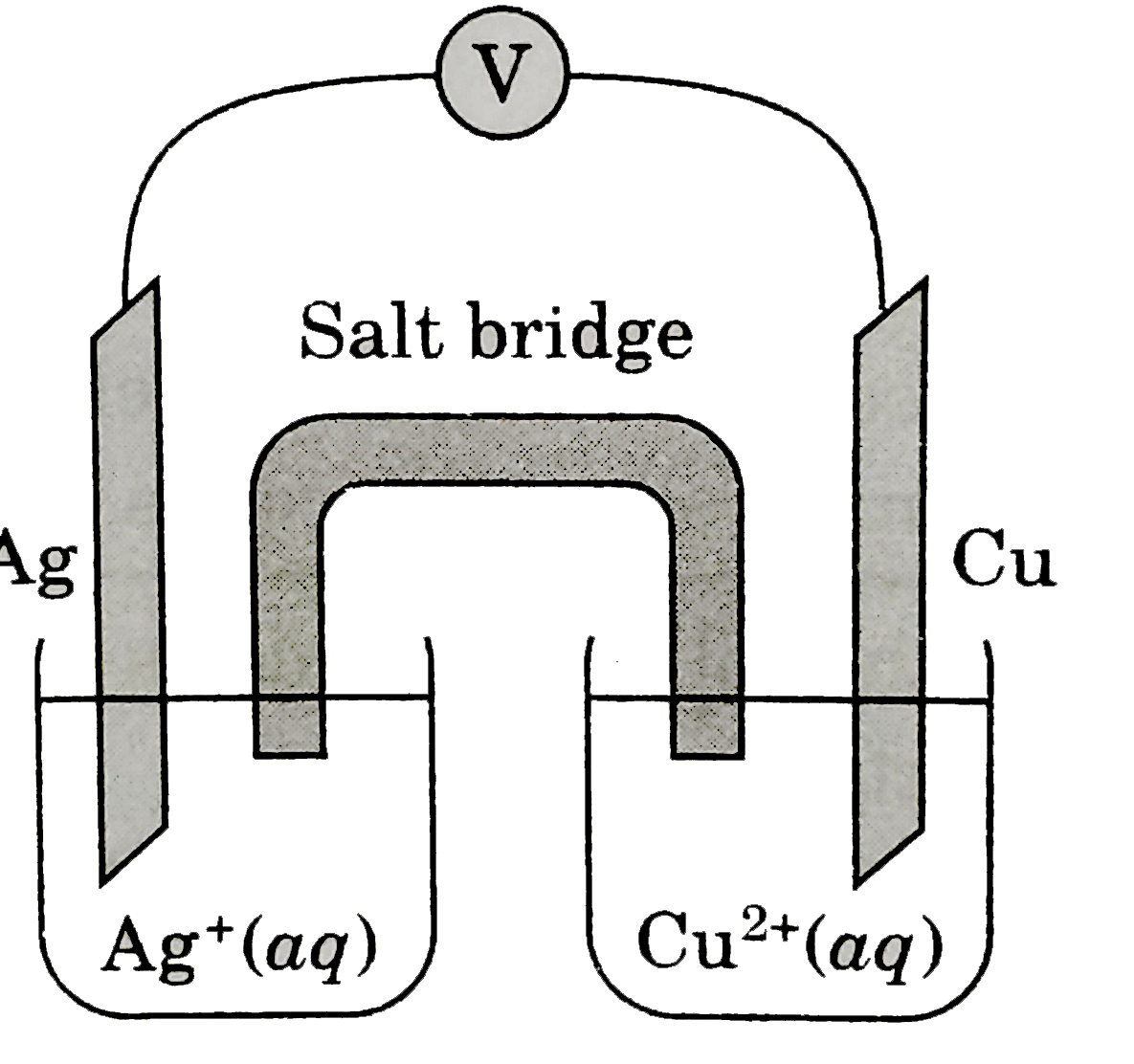The standard rectuion potentials for two half-cell reactions are given below
The standard free energy change for the reaction
is given by
The correct Answer is:C
To find the standard free energy change (ΔG°) for the reaction:
2Ag+(aq)+Cd(s)→2Ag(s)+Cd2+(aq)
we will follow these steps:
Step 1: Identify the Half-Reactions
The given half-reactions are:
1. Reduction of silver ion:
Ag+(aq)+e−→Ag(s),E∘=0.80V
2. Reduction of cadmium ion:
Cd2+(aq)+2e−→Cd(s),E∘=−0.40V
Step 2: Write the Oxidation Half-Reaction
Since cadmium is being oxidized in the overall reaction, we need to reverse the reduction half-reaction for cadmium:
Cd(s)→Cd2+(aq)+2e−,E∘=+0.40V
Step 3: Combine Half-Reactions
Now we can combine the oxidation and reduction half-reactions:
- Oxidation (anode):
Cd(s)→Cd2+(aq)+2e−
- Reduction (cathode):
2Ag+(aq)+2e−→2Ag(s)
Adding these gives the overall cell reaction:
2Ag+(aq)+Cd(s)→2Ag(s)+Cd2+(aq)
Step 4: Calculate the Standard Cell Potential (E°cell)
The standard cell potential is calculated using the formula:
E∘cell=E∘cathode−E∘anode
Substituting the values:
E∘cell=0.80V−(−0.40V)=0.80V+0.40V=1.20V
Step 5: Calculate the Standard Free Energy Change (ΔG°)
The relationship between the standard free energy change and the standard cell potential is given by:
ΔG∘=−nFE∘cell
Where:
- n = number of moles of electrons transferred (2 for this reaction)
- F = Faraday's constant (approximately 96500C/mol)
- E∘cell=1.20V
Substituting the values:
ΔG∘=−2×96500C/mol×1.20V
ΔG∘=−231600J/mol
Converting to kilojoules:
ΔG∘=−231.6kJ/mol
Final Answer
The standard free energy change for the reaction is:
ΔG∘=−231.6kJ/mol
---
The given half-reactions are:
1. Reduction of silver ion:
Ag+(aq)+e−→Ag(s),E∘=0.80V
2. Reduction of cadmium ion:
Cd2+(aq)+2e−→Cd(s),E∘=−0.40V
Since cadmium is being oxidized in the overall reaction, we need to reverse the reduction half-reaction for cadmium:
Cd(s)→Cd2+(aq)+2e−,E∘=+0.40V
Now we can combine the oxidation and reduction half-reactions:
- Oxidation (anode):
Cd(s)→Cd2+(aq)+2e−
- Reduction (cathode):
2Ag+(aq)+2e−→2Ag(s)
2Ag+(aq)+Cd(s)→2Ag(s)+Cd2+(aq)
The standard cell potential is calculated using the formula:
E∘cell=E∘cathode−E∘anode
Substituting the values:
E∘cell=0.80V−(−0.40V)=0.80V+0.40V=1.20V
The relationship between the standard free energy change and the standard cell potential is given by:
ΔG∘=−nFE∘cell
Where:
- n = number of moles of electrons transferred (2 for this reaction)
- F = Faraday's constant (approximately 96500C/mol)
- E∘cell=1.20V
ΔG∘=−2×96500C/mol×1.20V
ΔG∘=−231600J/mol
Converting to kilojoules:
ΔG∘=−231.6kJ/mol
The standard free energy change for the reaction is:
ΔG∘=−231.6kJ/mol
Topper's Solved these Questions
- ELECTROCHEMISTRYBook:DINESH PUBLICATIONChapter:ELECTROCHEMISTRYExercise:SELECTED STRAIGHT OBJECTIVE
Explore 67 Videos
- ELECTROCHEMISTRYBook:DINESH PUBLICATIONChapter:ELECTROCHEMISTRYExercise:MATCH-MATRIX
Explore 7 Videos
- ELECTROCHEMISTRYBook:DINESH PUBLICATIONChapter:ELECTROCHEMISTRYExercise:ADDITIONAL NUMERICAL PROBLEMS FOR PRACTICE
Explore 12 Videos
- D-AND -F BLOCK ELEMENTSBook:DINESH PUBLICATIONChapter:D-AND -F BLOCK ELEMENTSExercise:BRAIN STORMING MULTIPLE CHOICE QUESTIONS (MCQS)
Explore 13 Videos
- ETHERSBook:DINESH PUBLICATIONChapter:ETHERSExercise:(MCQs)
Explore 8 Videos
Similar Questions
The standard reduction potential for two reactions are given below
AgCl(s)+e−→Ag(s)+Cl−(aq),E∘=0.22V
Ag+(aq)+e−→Ag(s),E∘=0.80V
The solubility product of AgCl under standard conditions of temperature is given by
View SolutionUse the standard reduction potentials:
Sn2+(aq)+2e−→Sn(s) E∘=−0.141V
Ag+(aq)+e−→Ag(s) E∘=0.800V
To calcultate E∘ for the reaction:
Sn(s)+2Ag+(aq)→Sn2+(aq)+2Ag(s)
View Solution
Knowledge Check
The standard reduction potential for two reactions are given below
AgCl(s)+e−→Ag(s)+Cl−(aq),E∘=0.22V
Ag+(aq)+e−→Ag(s),E∘=0.80V
The solubility product of AgCl under standard conditions of temperature is given byA1.6×10−5B1.5×10−8C3.2×10−10D1.5×10−10The reduction potential of the two half cell reactions (occuring in an electrochemical cell) are
PbSO4+2e−→Pb+SO2−4(E∘=−0.31V)
Ag+(aq)+e−→Ag(s)(E∘=+0.80V)
The fessible reaction will beAPb+SO2−4+2Ag+(aq)→2Ag(s)+PbSO4BPbSO4+2Ag+(aq)→Pb+SO24−+2Ag(s)CPb+SO2−4+Ag(s)→Ag+(aq)+PbSO2−4DPbSO4+Ag(S)→Ag+(aq)+Pb+SO2−4The reduction potential of the two half cell reaction (occurring in an electrochemical cell) are
PbSO4(s)+2e−→Pb(s)+SO2−4(aq)(E∘=−0.31V)
Ag+(aq)+e−→Ag(s)(E∘=0.80V)
The feasible reaction will beAPb(s)+SO2−4(aq)+2Ag++(aq)→2Ag(s)+PbSO4(s)BPbSO4(s)+2Ag+(aq)→Pb(s)+SO2−4(aq)+2Ag(s)CPb(s)+SO2−4(s)+Ag(s)→Ag+(aq)+PbSO4(s)DPbSO4(s)+Ag(s)→Ag+(aq)+Pb(s)+SO2−4(aq)
Ag+(aq)+e−→Ag(s)E∘=0.80V
Cu2+(aq)+2e−→Cu(s)E∘=0.34V

What is the value for ΔG∘ when [Ag+]=[Cu+]=1.0M?
View SolutionConsider a voltaic cell based on these half - cell reactions
Ag+(aq)+e−→Ag(s):E∘=+0.80V
Cd+2(aq)+2e−→Cd(s),E∘=−0.40V
identify the anode and give the voltage of this cell under standard condition.
View SolutionThe standard electrode potentials for the reactions
Ag+(aq)+e−→Ag(s)
Sn2+(aq)+2e−→Sn(s)
at 25∘C are 0.80 V and -0.14 V respectively The emf of the cell Sn∣∣Sn2+(1M)∣∣∣∣Ag+(1M)∣∣Ag is
View SolutionThe standard electrode potentials for the ractions
Ag+(aq)+e−→Ag(s)
sn+(aq)+2e−→Sn(s)
at 25∘C are 0.80 V and -0.14 V respectively the emf of the cell Sn∣∣Sn2+∣∣(1M)∣∣Ag+(1M)∣∣ Ag is
View SolutionThe standard electrode potentials for the reactions,
Ag+(a.q)+e−→Ag(s)
Sn2+(a.q)+2e−→Sn(s) at 25∘C are 0.80 volt and −0.14 volt respectively. The emf of the cell
Sn∣∣Sn2+(1M)∣∣∣∣Ag+(1M)∣∣Ag is:
View Solution
